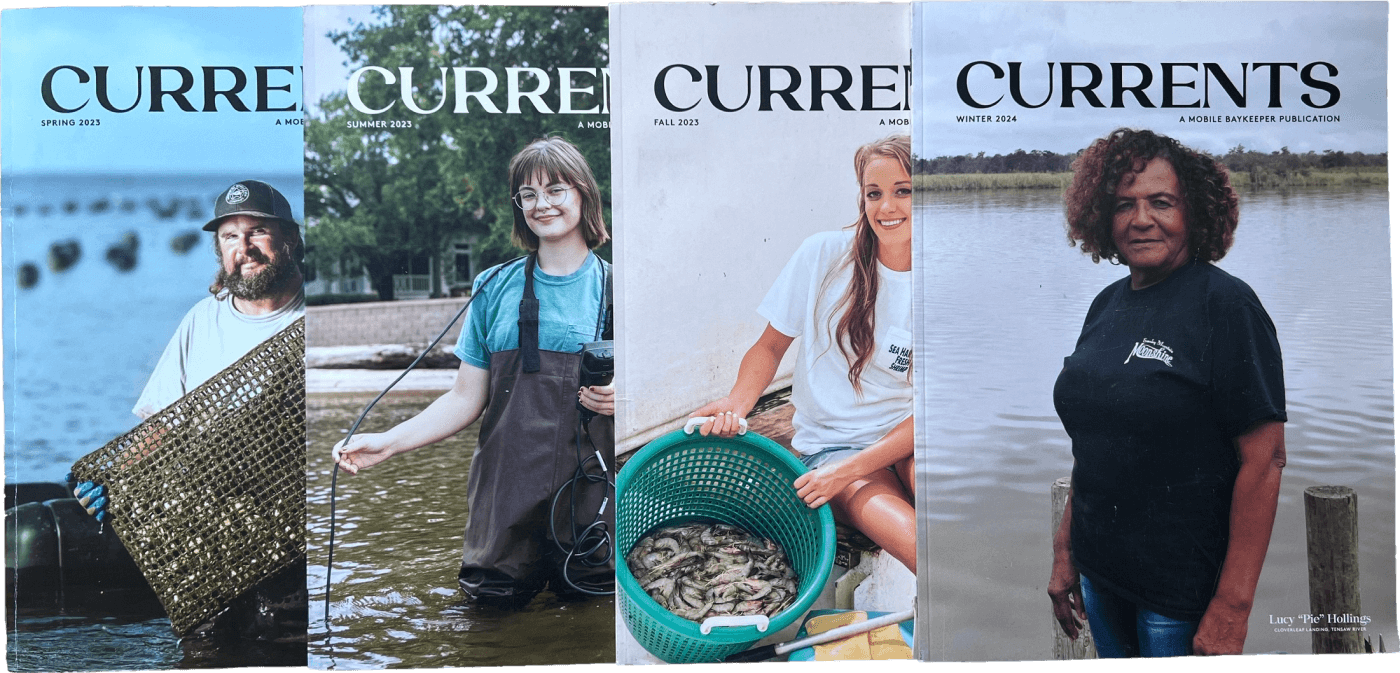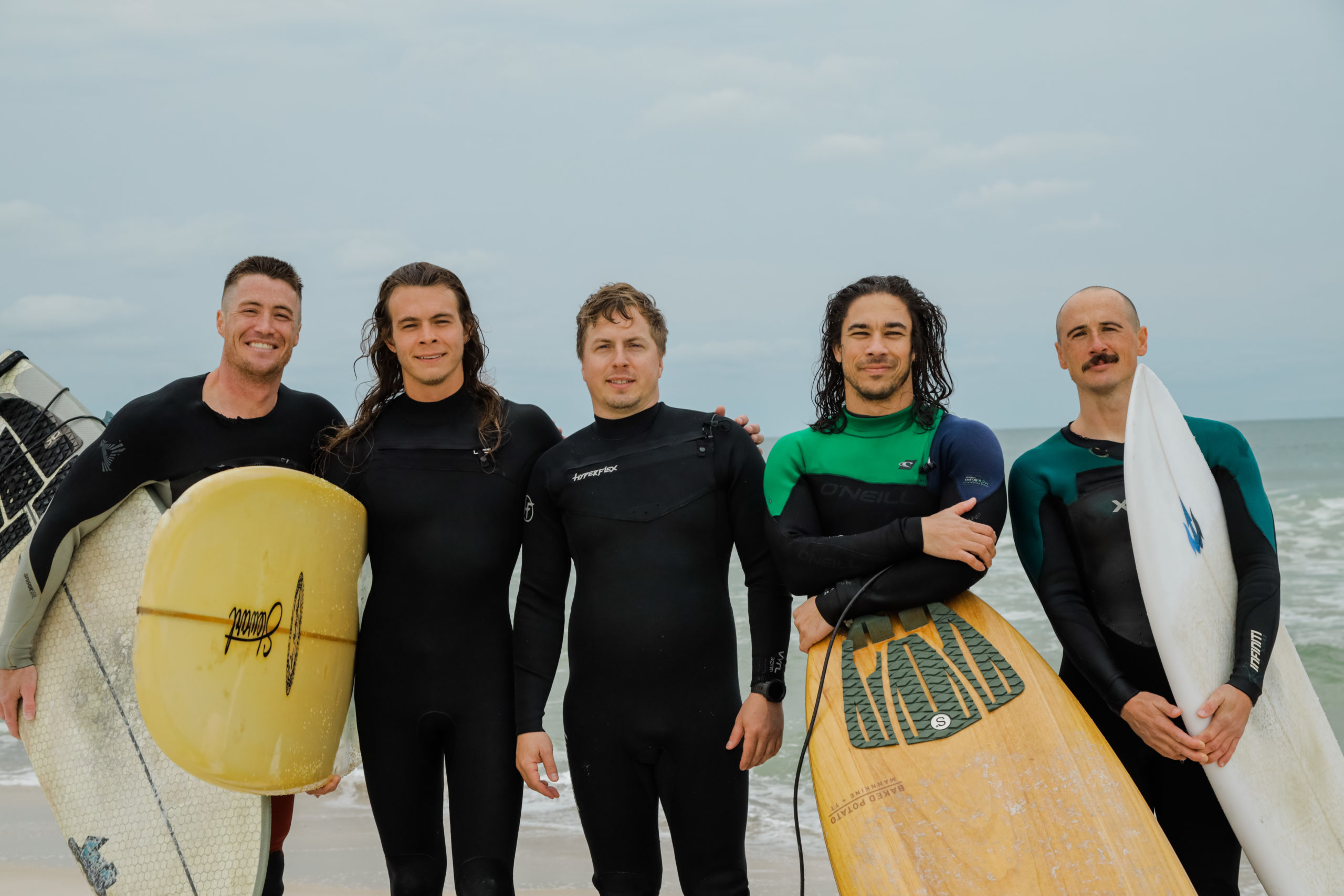
This article is from the summer 2024 edition of Mobile Baykeeper’s print quarterly, CURRENTS. The magazine is mailed to active members who have given more than $50 in the past year. To get on the magazine’s mailing list, donate here.
by Caine O’Rear | Photos by Courtney Mason Hilley
Austin Maynard thought his surfing days were over. This would be in the year 2010, in the time of the BP oil spill. “They were saying we might not be able to get in the water for years,” he says. “This was my life, and I didn’t think I was going to be able to surf again. That was a surreal moment.”
It was a surreal moment for anyone who called Coastal Alabama home. For a time — 87 days, in fact — it looked like the Gulf as we knew it was no more.
For those who live along the Gulf Coast, the water is the region’s lifeblood, the source of what sustains us. Just how much it meant to its residents came into razor-sharp focus in 2010. Nothing concentrates the mind like a world-class oil spill, the worst of its kind in history.
“It taught me that we need to be very careful of what we’re doing, and be aware that this could affect the future,” Maynard says. “I had never really thought about it before the spill, even though I saw those oil rigs out there all the time.”
As a Mobilian, Maynard grew up on the water. He started surfing with his brother, back in middle school. His uncles and cousins were surfers, and the day he made the switch from a boogie-board to a longboard he was hooked. Soon, his skater friends were tagging along as he explored the local surf breaks, the spots where the waves break over a sandy bottom and become surfable. By the time high- school came around, he was checking the daily surf report and jetting down to Dauphin Island most days after school. Because Dauphin Island is essentially one big sandbar, the breaks are constantly changing, so he and his friends would traverse the West End of the island, always on the lookout for the new spots.
Before long, Maynard was a real-live surf brah. He’d started watching surf films and soaking up the culture; he notes in particular the 2004 documentary Riding Giants, which traces the careers of famous big-wave riders like Greg Noll and Laird Hamilton. “When I started surfing, it pretty much changed my whole life,” he says. “I just became obsessed.”
Posters of the modern-day surf gods adorned his bedroom walls. Guys like the Irons Brothers, Kelly Slater, Rob Machado, and Dave Rastovich. Maynard studied the moves of these masters. He liked the surfers with a fluid style, the ones like Rastovich and Machado who were really smooth on the turns and cut-backs, and who weren’t afraid to experiment with different boards. He also dug how surfing informed so much of their worldview. “They always spoke about the culture and the ocean, and the importance of respecting the water,” he says. “That was something I kind of attached to.”
It wasn’t long before Maynard himself graduated to a shortboard, which is better suited for speed and maneuvering, especially when the swells get bigger. For Maynard, there was no looking back.
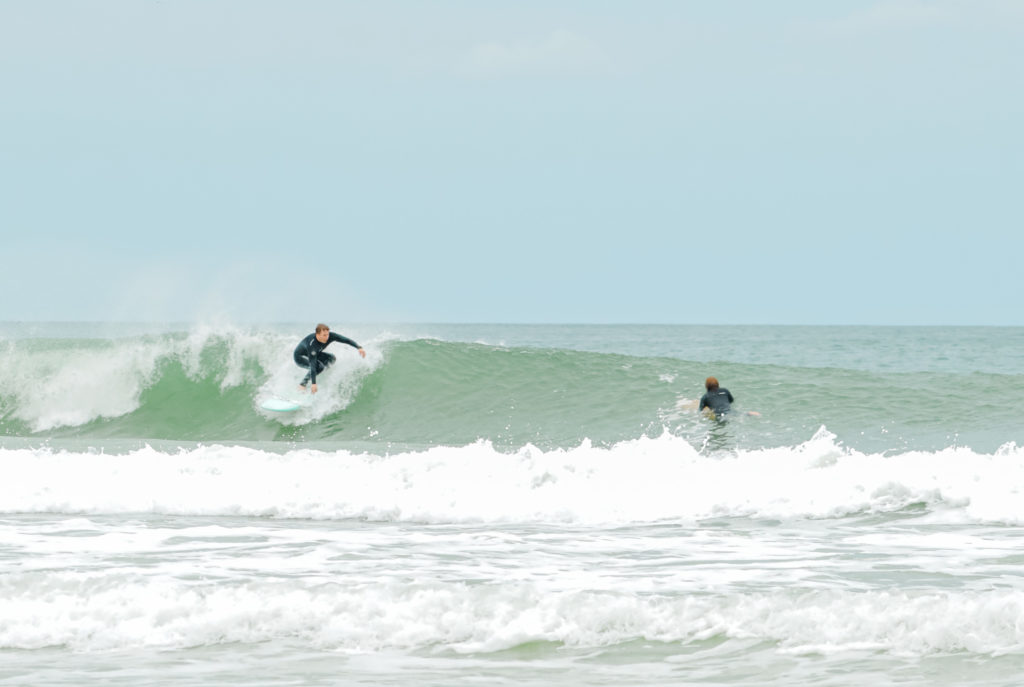
Surfing the Gulf
The Gulf of Mexico is a calm sea. The waves that lap its shores are not like the bigger swells you see along the Atlantic and Pacific coasts, or off the storied shores of Maui, where, along the surf-break at Pe’ahi, the waves on some days can reach between 30 and 80 feet when conditions are right.
Indeed, the Alabama coast is not known for its surfing. Its sugar-white beaches, some of the most prized in the world, are best for lounging about and swimming; for sunbathing and making sand-castles with the kiddos. For most of the year, the Gulf waters are warm and inviting, and you do not have to be an expert swimmer to enjoy them. Anyone can boogie-board or body-surf the waves, as long as the weather is reasonably good, and the rip currents are not too hazardous.
The Gulf is a relatively small body of water, compared to the greater oceans. The waves that roll in from the south have little time to gather the energy that make them surfable by the time they reach the northern coast. Surf conditions, for the most part, are the result of remote disturbances. The Florida Straits and Yucatan Channel — passages that mark the entrance to the Gulf — are populated with numerous reefs and shoals, which reduce most of the wave energy coming in from the Atlantic or Caribbean.
The topography of the continental shelf is also a factor. As you get closer to the coast, the seafloor of the Gulf begins to slope upward. That means a five-foot wave traveling in deep Gulf water is greatly reduced by the time it reaches the shore, due to the drag exerted on it by an increasingly shallow bottom.
Of course, this can all change during hurricane season, which runs from June through November in the Atlantic. When a northern front or major storm moves into the area, the conditions along the Gulf can approach those of America’s best surf spots. This is when the real action happens and the area’s hard-core surfers come out in full force – to taste the real thing for a few enchanted hours. You can find them surfing Alabama Point and The Cove in Orange Beach, or working choice spots in Pensacola, Fort Walton, and Panama City Beach.
For Maynard, surfing during storms can be thrilling, but it’s also offered some big lessons. “The power of the water humbles you, when you get too cocky and think you know it all,” he says. He recalls earlier attempts to surf during hurricanes, when he wasn’t quite ready and had no business being out there. “The ocean is way more powerful than you can imagine. It kind of puts you in your place.”
The Scene
“I love the surf culture down here,” says Cole Irvin, an assistant manager at Ron Jon’s Surf Shop, the go-to surf store in Orange Beach. “There’s a really strong community that is consistent about going out anytime there’s activity.”
Irvin concedes the Alabama coast is not a surf paradise, noting that two- to four-foot swells are the best we get, for the most part. He says a lot of the customers that come through his shop are would-be surfers looking for their first boards. Or they’re older salts coming in to accessorize a board they’ve had for years.
Irvin will usually start the newbies out on the longer, seven- to eight-foot foam boards, which have a price point of about $200 to $300. The foam boards offer buoyancy and make it easier to get up on smaller waves. The ones with more experience sometimes opt for an epoxy resin board, which is essentially a foam board with a hardened shell, and those go for about $450 to $500, he says, adding that some of them are “a work of art.”
Irvin says we have a strong skimboard culture along the Gulf Coast, and that sometimes bleeds into the surf scene, but he acknowledges the two are very different sports.
“Surfing is just iconic with the beach,” he says. “Generally, the folks that come looking for a board are just curious. If there is good surf, they want to go out and give it a shot.”
The Cove
When I met Maynard and his crew back in March, I didn’t know what to expect. I understood the spring months were typically slow for surfing, so I tried to manage expectations. And I had no idea what Gulf surf culture was like. When I was growing up, surfing was not something you did in Alabama, as far as I knew. Like ice-fishing or hockey, it just wasn’t on the radar.
A few days before the shoot, Maynard texted and said conditions were looking good for Saturday afternoon. A front had moved in and they were expecting swells that day around 2 p.m. When you surf in Alabama, you have to get after it when the getting’s good, and that means staying vigilant of weather conditions, down to the exact hour sometimes. Here, you take what Mother Nature gives you, and the good days are few and far between. It is not a hobby for fair-weather dilettantes.
It was windy and overcast when I met Maynard and co. in the parking lot at Cotton Bayou (or The Cove, as it’s more commonly known to the surf crowd), next to the Four Seasons in Orange Beach. As I was driving over, Maynard called and said conditions peaked a few hours earlier than had been forecast – such is Alabama surfing.
The Cove is one of the most popular surf-spots along the state’s 60-mile coastline. A concrete pier extends from the pool deck of the Four Seasons across the beach, then juts out into the Gulf for about 700 feet. The pier is what upholds the integrity of the sand bar, which creates the surf-break. “Even if we have a big storm, that sand bar will still hold itself up,” Maynard says.
By the time I arrive there are five or six surfers working the east side of the pier. Some of them have been out since mid-morning. A tourist from the Midwest stops me.
“I didn’t know you could surf here,” he says.
We look out at the break and watch as one of the surfers maneuvers a fancy cut-back on a three-foot swell.
“I didn’t either,” I say.
(Click photos to enlarge.)
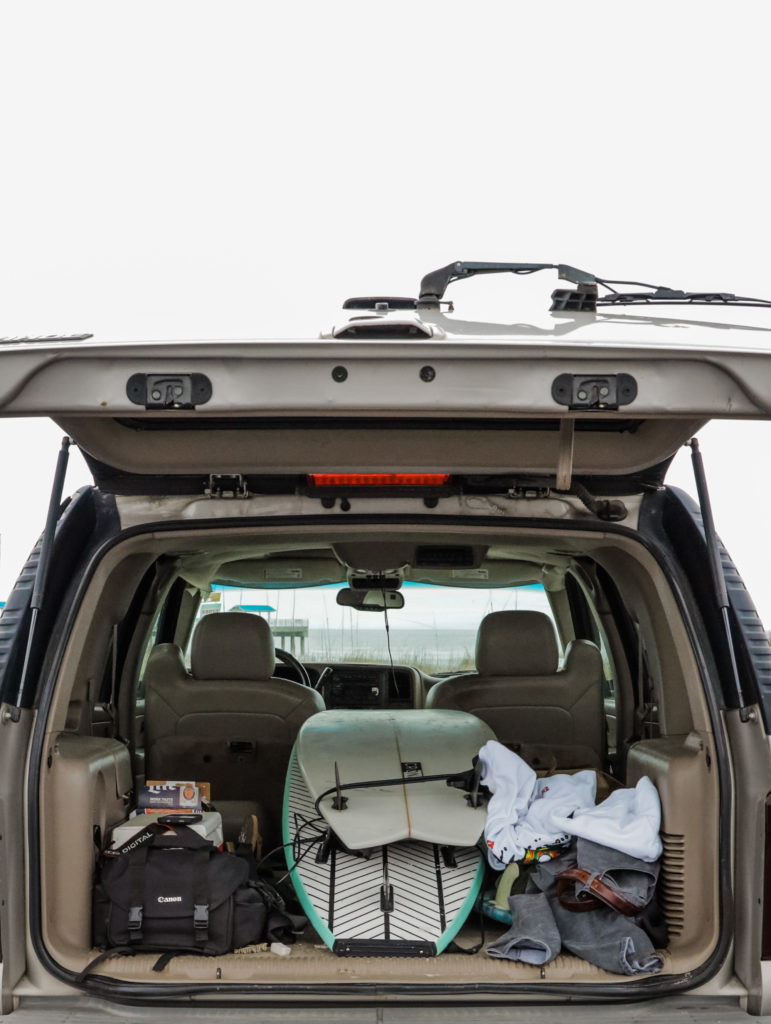
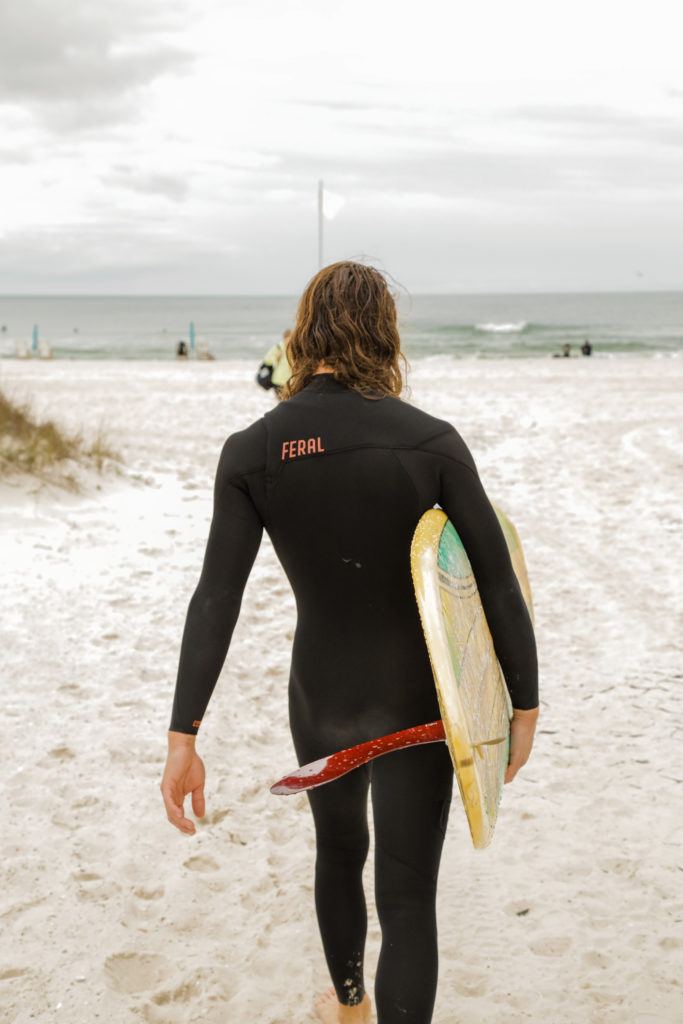
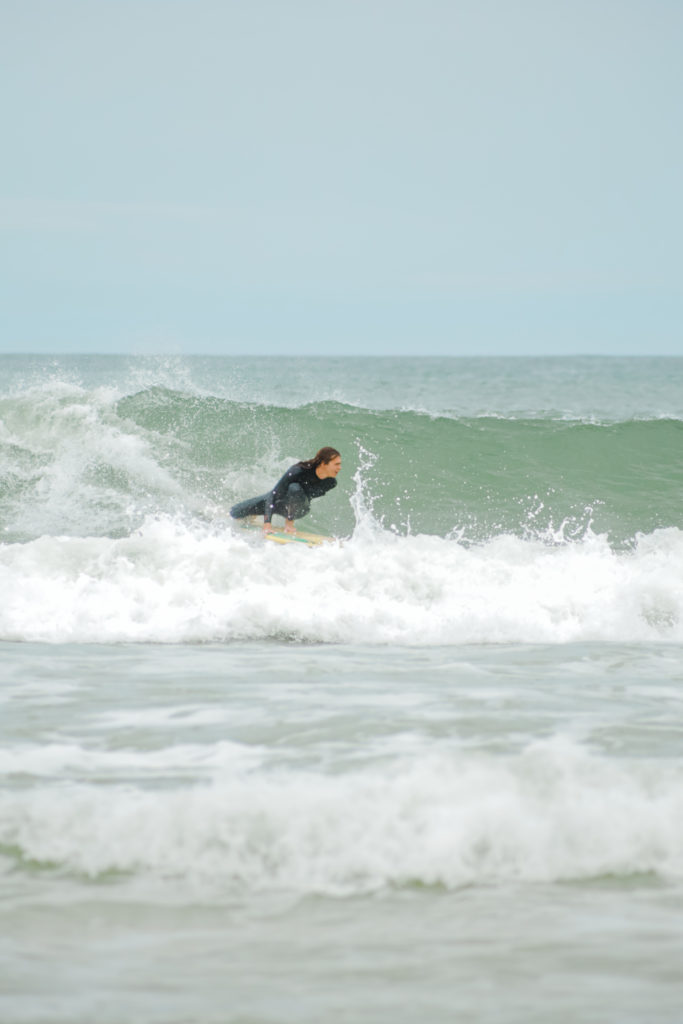

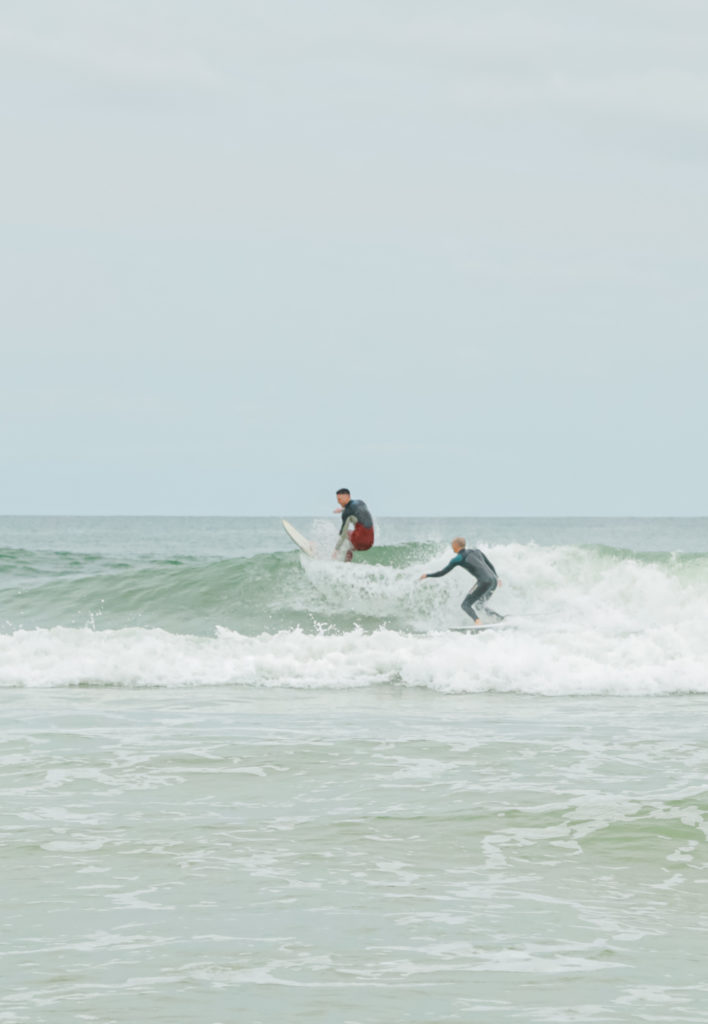
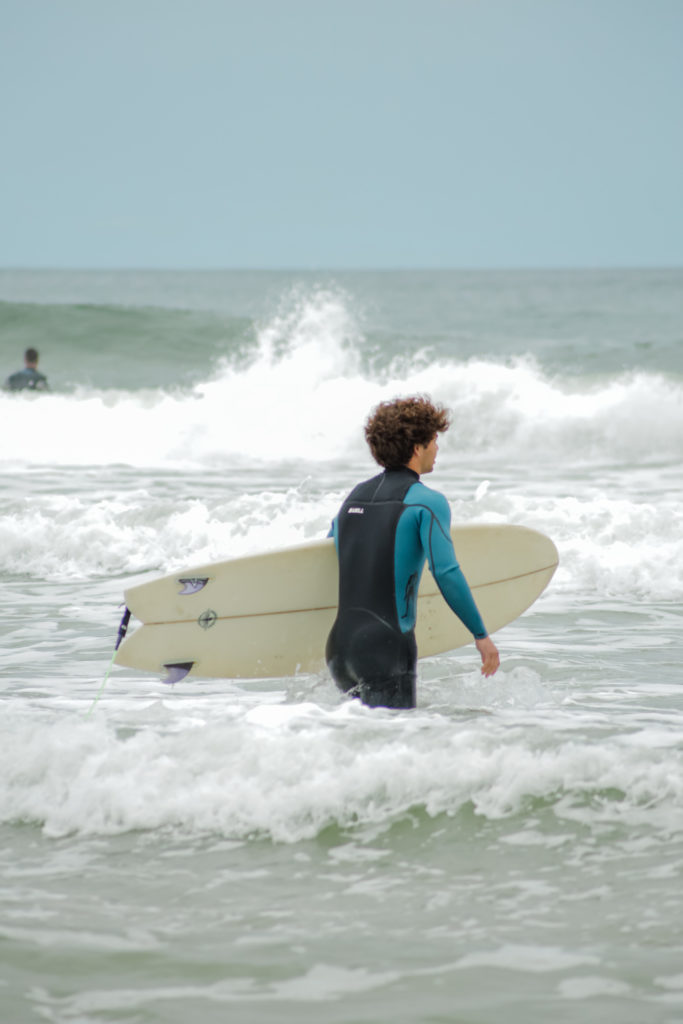
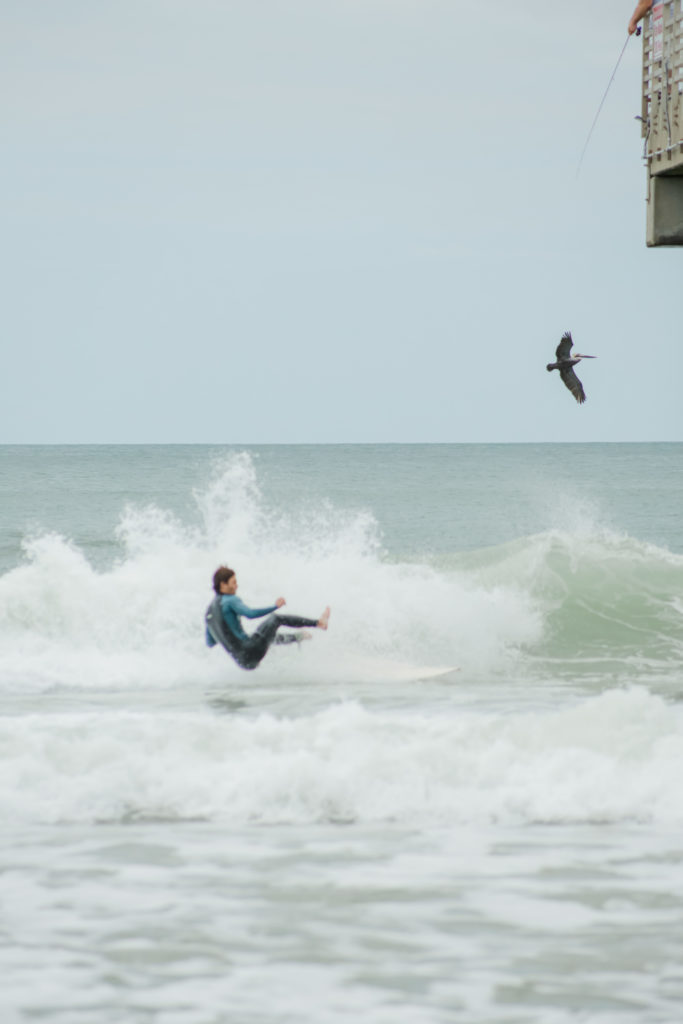
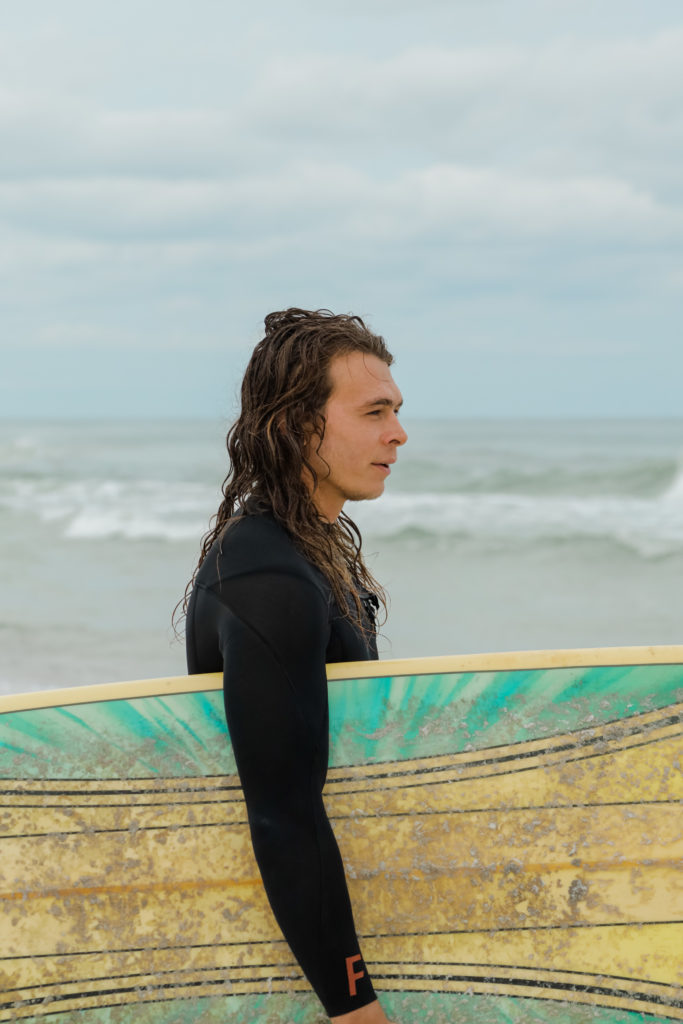
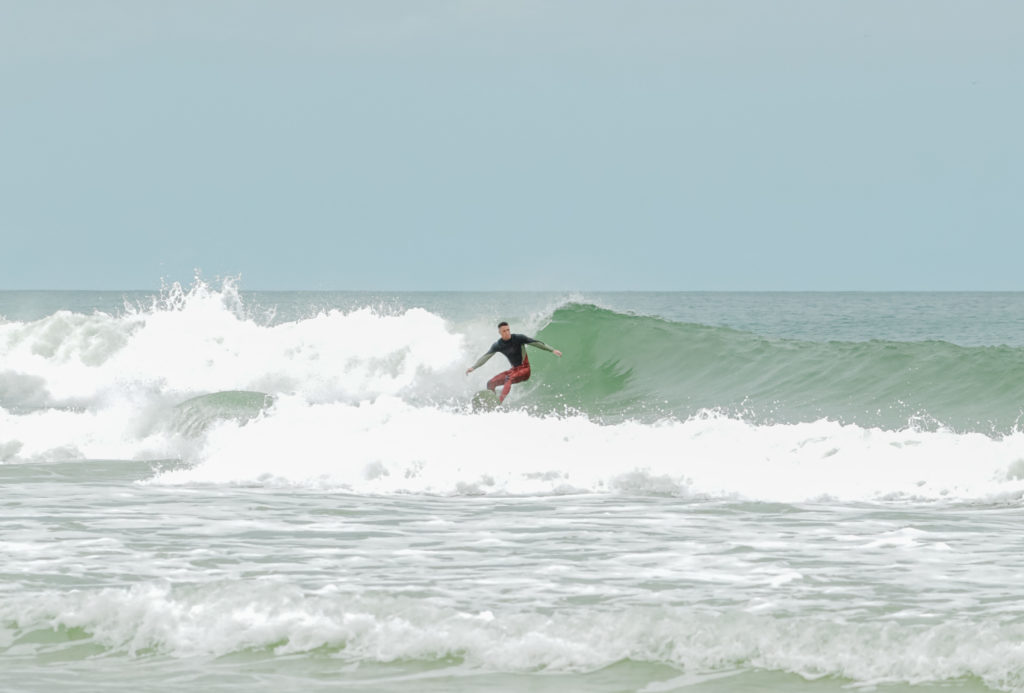
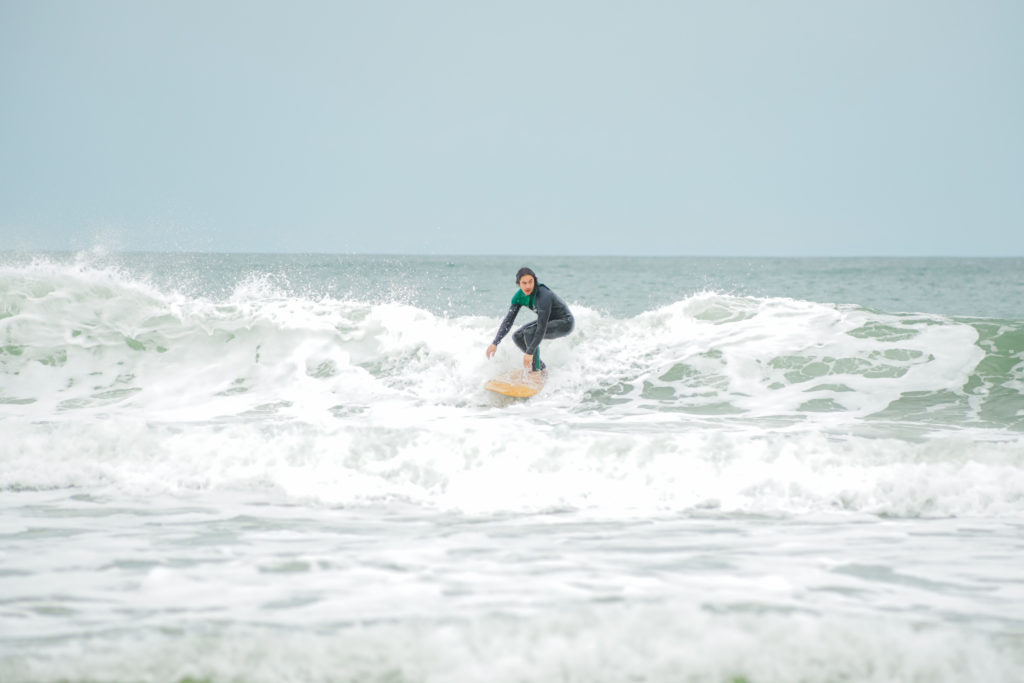
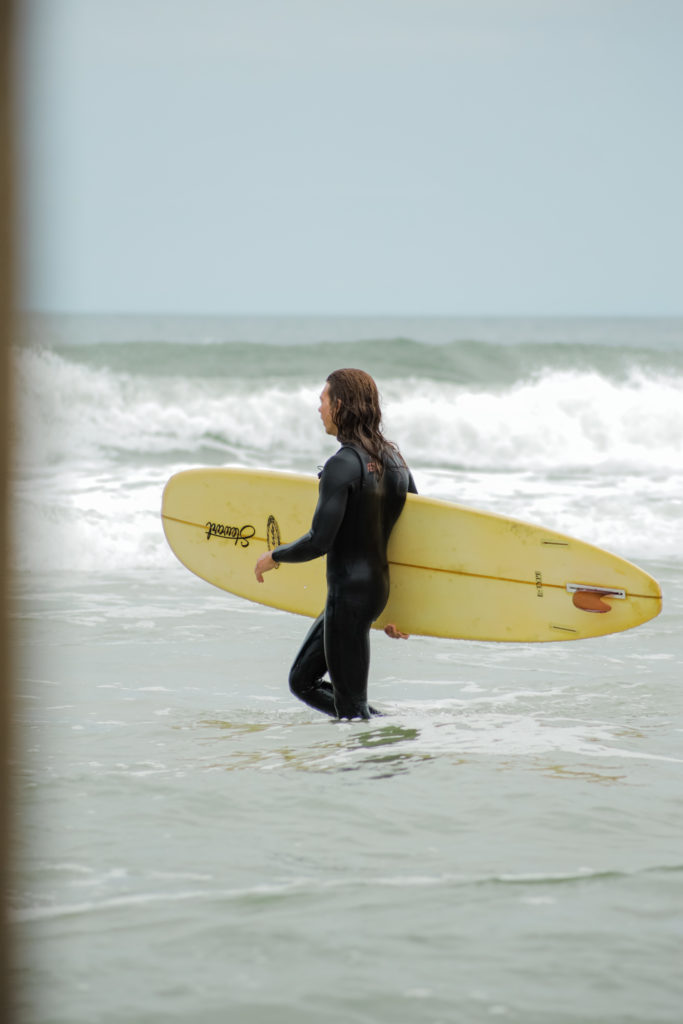
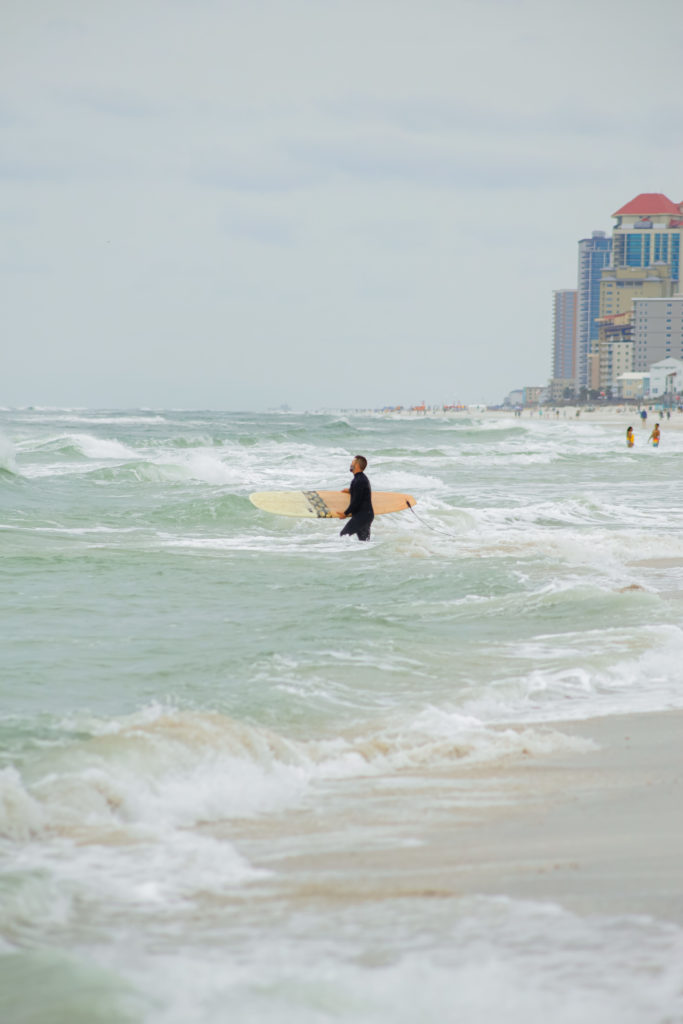

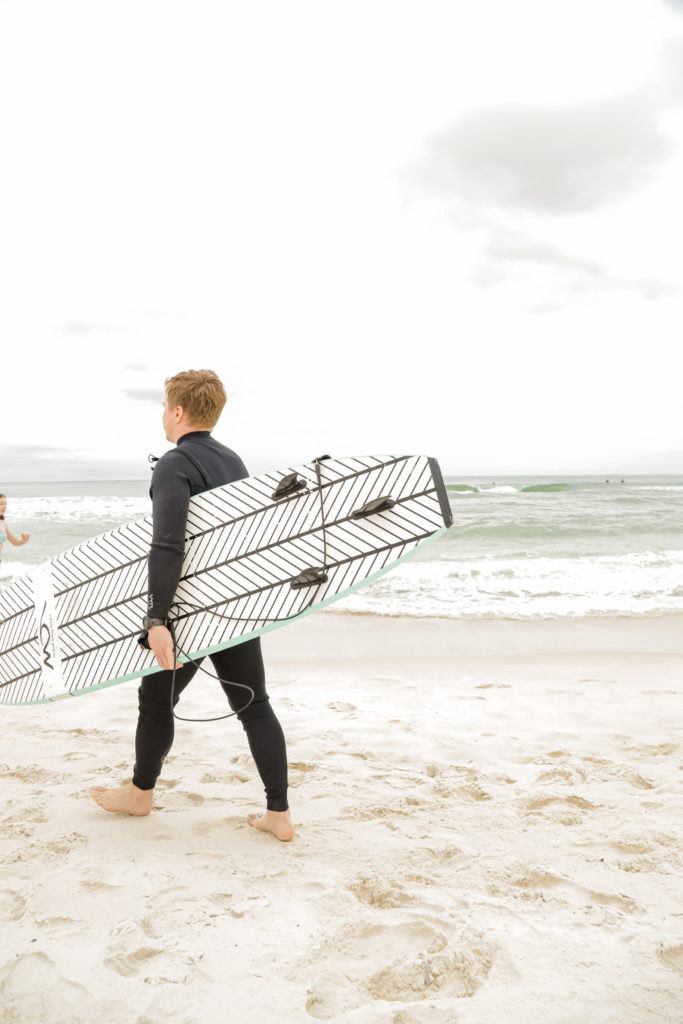
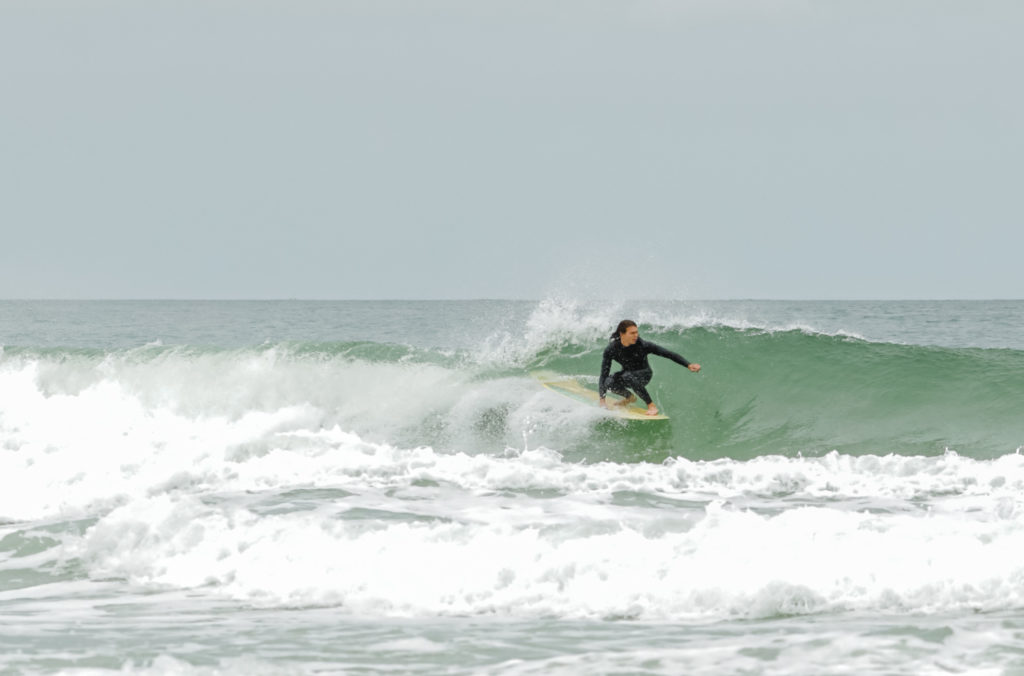
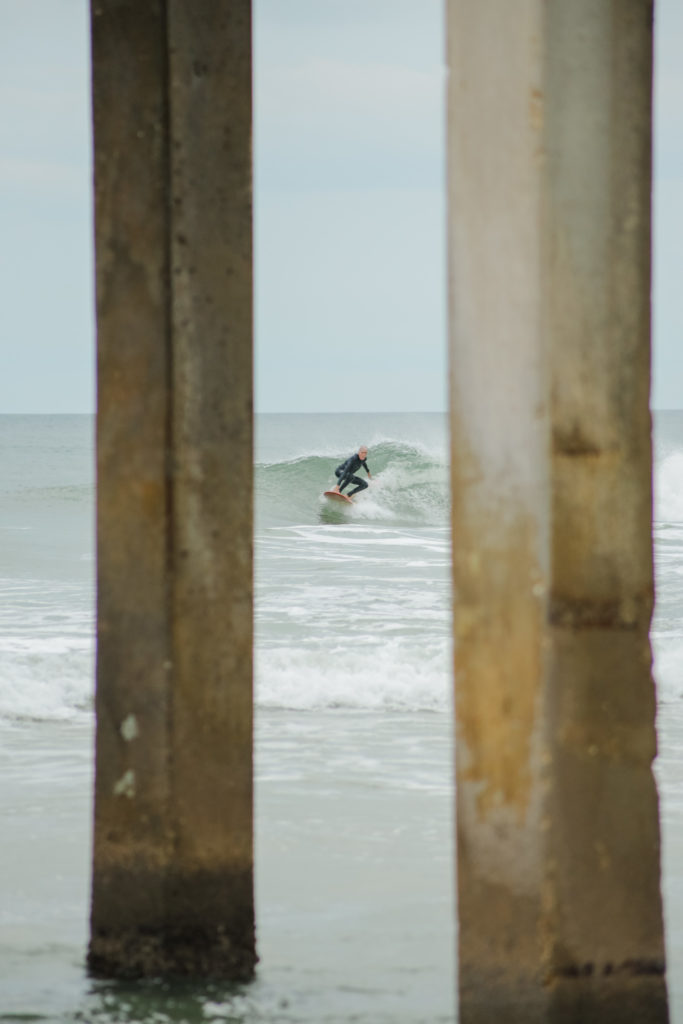
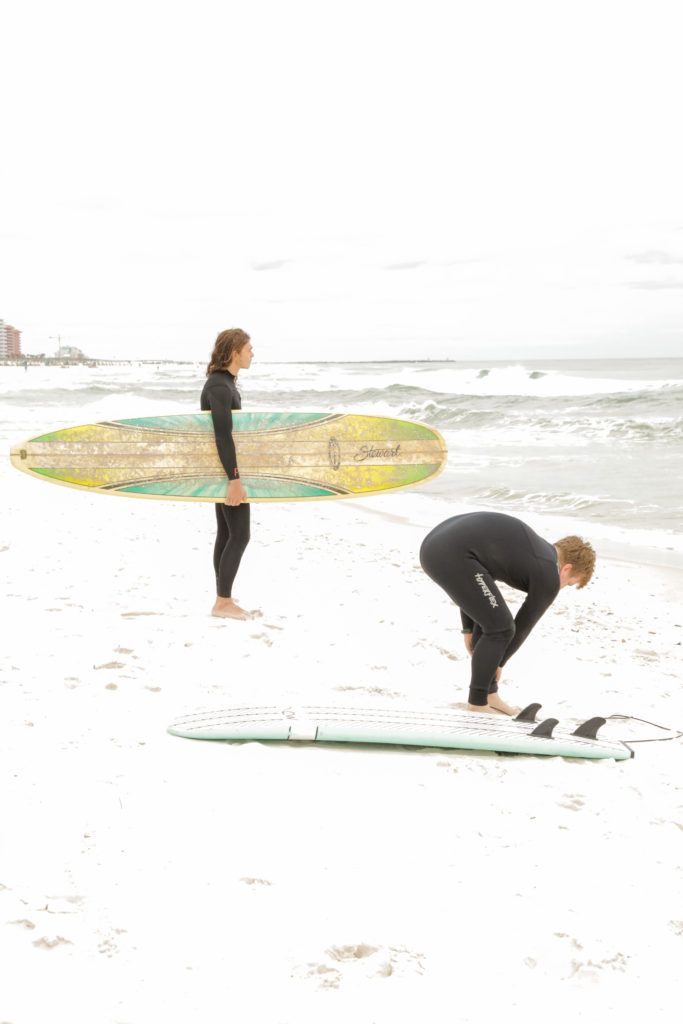
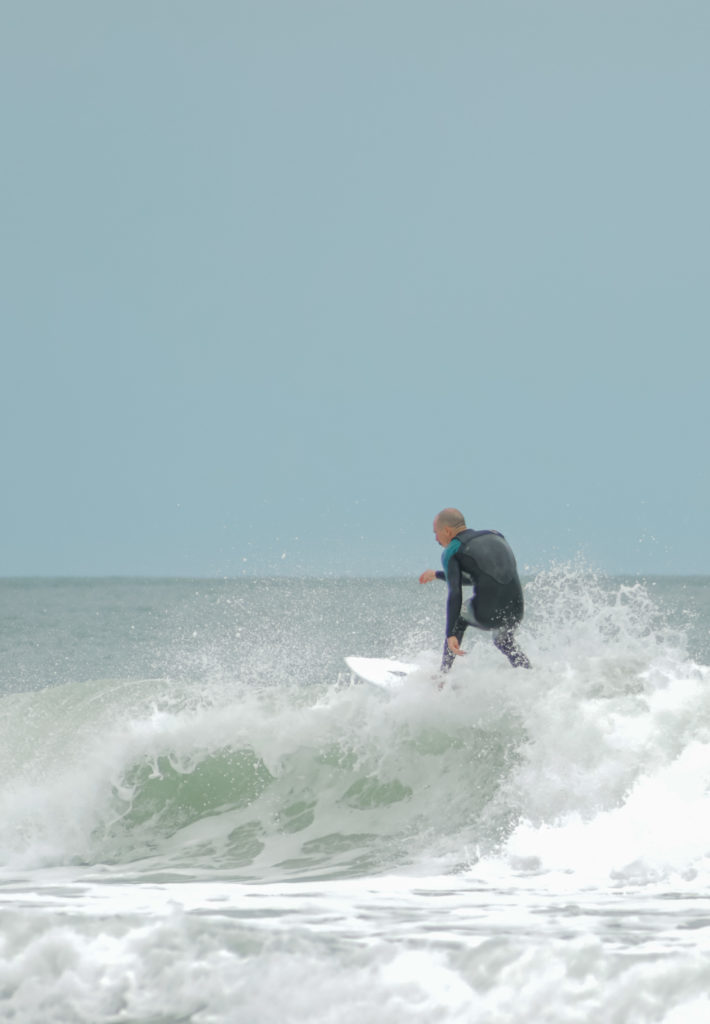
The Crew
If the surf scene in Alabama is about anything, it’s about camaraderie – about being out there and enjoying the water with family and friends. I chatted with five of Maynard’s buddies that day in March, all of them super-cool. A lot of these guys had gotten to know each other through surfing as teenagers.
Here are a few of the ones I met:
Stephen Adams: Tall and long-haired with a good tan, Adams, who grew up in Fairhope, looks every inch the surfer.
“Compared to the West Coast, we get about two good days a year,” he tells me. “For us, it’s fun and smooth, and about once a month, it will be decent like this. The only time it gets really good is when we get a storm and the wind immediately goes off shore, and we get maybe six hours of surf and that’s it. So you really gotta be on it.”
Adams monitors the surf conditions by using the National Data Buoy Center, which is part of NOAA’s National Weather Service. The NDBC reports on wave height and period, as well as wind speed, direction, and atmospheric pressure.
“They give swell readings and report on the waves at so many feet at so many seconds,” he says. “They also give you the tides and the pressure. All that goes into how the waves are going to look.”
Adams is surfing a nine-foot longboard when I meet him, but earlier that morning, when the swells were bigger, he was working a shortboard. “With the way it is now, it’s a little more fun on a long- board,” he says. “I can catch more waves. It’s a little more buoyant.”
Because of the Gulf ’s sandy bottom, it can be difficult to read and anticipate the waves, especially for beginner surfers. There are no reefs or rock bottoms to create consistent breaks that are easier for surfers to spot. “It changes every day,” Adams says. “You have to look at where it’s manageable every time you go out, pretty much.”
Kale Troha: A resident of Gulf Shores, Troha got his start skimboarding as a teenager. He competed for the now-defunct Blond John’s team and made the “easy switch” to surfing in his early 20s.
These days he surfs a fish egg, a type of shortboard with a rounded tail that allows for less water resistance.
He says his best day of surfing came during Hurricane Sally or Hurricane Michael, storms that created a “double overhead” (a wave with a face height of about 12 feet), easily the biggest swells he’s ever surfed.
For Troha, who runs the coffee shop FOAM in Gulf Shores with his wife, surfing offers an escape from the day-to-day. “When you have a stressful day, and you’re able to get out on the water, you forget about everything, and you’re focused on that one wave each time. You’re trying to get the best wave and the best outcome from it. And there’s just something about being out there in Mother Nature and being with your friends and just enjoying it.”
Carl Stokley: When he was eight years old, Stokley started surfing with his dad. He didn’t take to it at first, as he had trouble paddling out to the breaks by himself. But he soon discovered the older surfers were willing to help out any young grom who needed it.
Today he surfs on a board just over seven feet in length, which isn’t quite a longboard, but it’s not exactly a shortboard either. He’d been out in the water for about four hours when I met him that day. “This morning, it was really glassy, it was just a treat,” he says.
While surf conditions are not often the best in Coastal Alabama, Stokley says it’s always worth going out. “You just see all these guys you grew up surfing with out here. And my dad taught me and my little brother, that’s always one of the best parts. We all come out here. It’s just family-fun time.”

John Tanner: A former marine biologist, Tanner grew up in Gulf Shores and now runs a CrossFit gym in Orange Bach. He likes to surf on a shortboard (his current setup is just over five feet), which he says is a little more responsive than a longboard. “It’s faster on the drop, faster on the turn,” he says, “so you can catch some pretty good waves on it.”
Nate Howell: Growing up in Perdido Key, Howell got into surfing through his dad, a life-long practitioner of the sport. He says his best day of surfing came in the fall of 2019, when Tropical Storm Nestor rolled ashore, a disorganized front that created over ten- foot swells offshore.
Howell says he favors a slight north wind at about ten to 12 miles per hour. For him, surfing is about the connection to nature and just being out in the water. “It’s good exercise too,” he says.
Guy Yaste: The elder statesman of the Alabama surf scene, Yaste started surfing these waters as a teenager in the ’60s. He says he used to work Alabama Point, on the east side of the bridge, when there was nothing down there. He learned by trial and error at a break they call Spuds, not far from the Flora-Bama, where he and a few other Alabama surfers developed a friendly rivalry with some of the Pensacola crowd.
Asked if he’s got any advice for newbies, he remarks, “Just start with a longboard and take your time. Don’t try to get out there with the young guys. Just get out there and do it. But be patient. I’ve been surfing since I was 16 years old.”
Red Flags
If there’s an occupational hazard to surfing, it’s the rip currents, the strong water channels that flow away from the shore, often near breaks and sandbars. These currents can travel as fast as eight feet per second, and in the summer of 2023, they killed ten people in Alabama alone in the span of two weeks.
Maynard stresses that anyone who enters the Gulf should be a really good swimmer. He says the flags are sometimes not enough of a deterrent, noting that even yellow-flag status can be dangerous for those who’ve only swum in pools or lakes, and can’t do much more than doggy-paddle. “Most people have no idea about the power of the Gulf. They get in there and before you know it, you get sucked into a rip tide and start panicking.”
Maynard recounts one experience surfing The Cove when he and some fellow surfers rescued a girl of six or seven. She’d got caught in a rip current and, after being spotted by one the surfers, was able to latch on to the leash of Maynard’s surfboard, even though the current continued to sweep them under the Four Seasons pier, which can be extra dangerous given how barnacled the pilings are. When they finally got back on shore and found the girl’s parents, maybe two or three hundred yards away, they appeared to be under the influence and oblivious to what had happened. “People can act really dumb down here, once they cross that bridge,” Maynard says. “It’s just lack of respect for the ocean. The lifeguards really have their hands full.”
Victory at Sea
Twenty years ago I spent a week in Costa Rica, on a popular surfing beach called Playa Grande off the Pacific Coast. I was not a surfer but the lodging was cheap and you could get your own cabana for just ten or fifteen dollars a night. The place teemed with California brahs with Bodhi-like attitudes. Soon after arriving it became clear I was not part of their tribe and there was no way to get in on the action. Clearly, these guys had no time to tutor saplings like myself – it seemed my surfing days were over before they’d begun.
When I drove to Orange Beach in March, I wasn’t sure if Alabama surfing was a novelty or not. How serious could these guys be? I thought of surfing as a hobby made for more exotic locales. There was a mystical aspect to it, too, I felt, a sacred element that didn’t jibe with the culture of the Redneck Riviera.
But I had always wanted to surf. Who hasn’t felt that pull? Seeing the movie Point Break as a kid made you want to ride the waves, in the same way that hearing a Slash solo made you want to get a Les Paul and start playing electric guitar.
For Gulf residents, the pall cast by the BP oil spill has mostly passed, but its memory lingers. Hearing Maynard talk about those white-knuckle days reminds one of the fragility of our waters and how they can’t be taken for granted. It is clear Austin and his crew have a special connection to the Gulf — one much deeper than my own. This alone makes me want to get a board and take to the waves.
“All life stems from the ocean, as far back as time,” Maynard says. “You come home after being out there and you feel recharged. You can’t help but feel better, being out in the saltwater and the sun. That’s why I live down in Orange Beach now. It does something to the soul.”
Top photo: (Left to right) Carl Stokley, Stephen Adams, Austin Maynard, John Tanner, Kale Troha.
